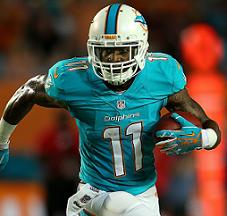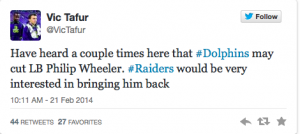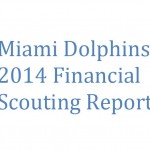The news broke today that Ndamukong Suh is set to sign a record breaking $19 million per year contract with the Miami Dolphins on Tuesday. Rumors are that Suh will receive $60 million guaranteed and at least $55 million in the first three years. That latter number is roughly in line with what was earned by JJ Watt and Mario Williams on their most recent record setting contracts. The $19 million total is unlike any in the history of the NFL. Is Suh worth it?
At an annual salary of $19 million a year, Suh becomes our top NFL “position buster”. A position buster is a player whose salary so far exceeds the norms the position they require an extra special player to warrant such a salary. Usually for this index I use the 5th highest paid player at the position. Here is my current chart:
| Position | Player | APY | 5th Highest APY | % Increase |
| DT | Suh | $19,000,000 | $7,287,500 | 160.7% |
| 34DE | Watt | $16,666,667 | $6,875,000 | 142.4% |
| RB | A. Peterson | $14,380,000 | $7,600,000 | 89.2% |
| WR | Johnson | $16,207,143 | $11,111,111 | 45.9% |
| CB | P. Peterson | $14,010,000 | $10,020,000 | 39.8% |
| C | Pouncey | $8,827,325 | $6,458,750 | 36.7% |
| TE | Graham | $10,000,000 | $7,350,000 | 36.1% |
| 43OLB | Briggs | $7,000,000 | $5,250,094 | 33.3% |
| 43DE/34OLB | M. Williams | $16,000,000 | $12,050,000 | 32.8% |
| G | Mankins | $8,500,000 | $6,750,000 | 25.9% |
| S | E. Thomas | $10,000,000 | $8,000,000 | 25.0% |
| T | T. Smith | $12,200,000 | $10,000,000 | 22.0% |
| QB | A. Rodgers | $22,000,000 | $19,000,000 | 15.8% |
| ILB | Willis | $10,000,000 | $8,750,000 | 14.3% |
In looking at the above chart it would seem that the contract was strongly based on JJ Watt’s recent contract extension with the desire from Suh to push the price as a generational player similar to Watt. I think most agree Watt is a generational player coming from a 34 defensive end position. But is Suh that kind of player for a defensive tackle? Let’s examine using some of the statistics maintained by Pro Football Focus
Pass Rushing
Suh is one of just 10 defensive tackles that has rushed the passer more than 700 times in the last two seasons. That is something that makes him unique. It means there is essentially no pass situation that he can not play in. Here is how Suh stacks up in his pass rushing performance against that group of players:
| Player | Snaps | Sacks | Tot. Pressures | % Sacks | % Hits/Hurries | % Total Pressures |
| McCoy | 942 | 19 | 125 | 2.0% | 11.3% | 13.3% |
| Suh | 1073 | 13 | 129 | 1.2% | 10.8% | 12.0% |
| Atkins | 749 | 9 | 74 | 1.2% | 8.7% | 9.9% |
| Dareus | 834 | 18 | 74 | 2.2% | 6.7% | 8.9% |
| Marks | 922 | 13 | 77 | 1.4% | 6.9% | 8.4% |
| Babineaux | 919 | 3 | 75 | 0.3% | 7.8% | 8.2% |
| Odrick | 949 | 6 | 74 | 0.6% | 7.2% | 7.8% |
| Poe | 1110 | 12 | 63 | 1.1% | 4.6% | 5.7% |
| Hayden | 771 | 0 | 34 | 0.0% | 4.4% | 4.4% |
| Brockers | 718 | 8 | 30 | 1.1% | 3.1% | 4.2% |
Clearly this is very good for Suh, but he doesn’t rank first as that distinction goes to Gerald McCoy, who recently signed for $13.6 million per season and will earn about $44.5 million over three years. Sen’Derrick Marks provides the best value at $4.5 million per year. Still Suh has clearly put himself into an elite class.
Run Defense
For run defense I mainly just want to look at stops, which are basically the big stuffing type plays that Suh will make. Suh is one of 19 defensive tackles that has played more than 500 run snaps over the last two seasons. Everyone on the above list also made the cut except Atkins, whose injury filled 2013 saw him just miss out. Here is how our subset of players performs.
| Name | Snaps | Tackles | Stops | Tackle % | Stop % |
| Dareus | 568 | 75 | 60 | 13.2% | 10.6% |
| Suh | 559 | 59 | 51 | 10.6% | 9.1% |
| Poe | 733 | 68 | 53 | 9.3% | 7.2% |
| Brockers | 610 | 47 | 39 | 7.7% | 6.4% |
| McCoy | 612 | 46 | 38 | 7.5% | 6.2% |
| Babineaux | 604 | 41 | 37 | 6.8% | 6.1% |
| Odrick | 635 | 48 | 37 | 7.6% | 5.8% |
| Hayden | 534 | 48 | 31 | 9.0% | 5.8% |
| Marks | 651 | 37 | 34 | 5.7% | 5.2% |
Again Suh is not the best player, but again he has separated himself from the field with a 10.6% tackle rate and 9.1% stop rate. This is the category where he separates himself more from McCoy.
Soft Factors
While these produce some type of expected statistical performance, PFF actually grades players on every snap. There may be a large number of plays where Suh is standing out and simply not getting a statistical grade for it. So I’ll look at their run and pass grades (I don’t see coverage or even penalties having a bearing on this) and weigh them at 43/57% which is basically the run/pass split in the NFL.
| Name | Rush | Run | Com. Score |
| McCoy | 88.7 | 1.8 | 51.3 |
| Suh | 49.1 | 22 | 37.5 |
| Dareus | 14.2 | 34.4 | 22.9 |
| Odrick | 19.1 | -1.4 | 10.3 |
| Marks | 21 | -16.8 | 4.8 |
| Poe | 4.5 | 4.4 | 4.5 |
| Babineaux | 0.2 | -6 | -2.5 |
| Brockers | -11.4 | 0.5 | -6.3 |
| Hayden | -24.4 | -35.6 | -29.2 |
This kind of confirms what we saw above. Over the last two seasons Suh is in an elite category, but it is certainly arguable whether or not he is the best at the position, let alone worth that much more than McCoy.
Final Take
For this kind of deal to work out for Miami Suh will either need to continue to improve in both facets of the game (his run performance spiked significantly in 2014) or have a material impact on his what is a decent defensive core around him. While that did not seem to be the case in Detroit (most year’s their defense was poor) the Dolphins do have better personnel. Miami may consider the fact that the current overwhelming weakness in the AFC East is line interior line play which can also benefit the statistical impact that Suh can have or help the team have.
Miami may also view Suh as one of a few players in the NFL at the position that can play all three downs. Those players are not available that often, at least ones who are very good. They may see Suh at $19M a better investment than drafting a player and hoping they become a high quality three down player or having to sign a run-stuffer and situational rusher for likely $10-$11million combined and likely not getting the same result as Suh. On a per dollar basis it’s clear Miami will lose out here, but they have virtually no risk of failure beyond injury, and that exists with every team.
In most of these cases of the big contract, the perception of the greatness of the player clouds the judgment of an organization when it comes to valuing the player. The fear of life without the player far exceeds the potential negative risk that signing such a contract will cause. For Suh he caught the perfect storm to earn this contract. The Lions poor handling of Suh’s contract made Suh a giant focus of the last two years furthering the reputation of the player. Suh’s nasty on the field antics made sure he was a household name like few others that play defense. It was essentially a free marketing tool that caused a market frenzy like no other.
Few of these big deals work out for a team, at least to the expected levels. Certainly the Peterson and Johnson led offenses haven’t led to deep playoff runs. Former position busters like Nnamdi Asomugha (Raiders), Darrelle Revis (Buccaneers), and Chris Johnson (Titans) have led to poor results. Mario Williams was arguably a position buster and it took years for that defense to become great around him and it still hasn’t even led to one playoff game. Maybe Suh will be the player to change it. Miami is certainly banking on it.



